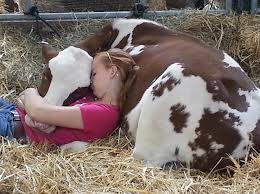Instilling Compassion in Children
by Shayla Roberts
Chances are that if you are vegan one of the deciding factors for you was compassion for animals. I had always toyed around with the idea of vegetarianism, but when surfing the web one day, I came across a PETA page with pictures that changed my life. I could no longer be blissfully ignorant. I never had another piece of meat. Dairy, eggs, and leather followed shortly. All I knew was that I didn’t want to support an industry that caused so much suffering. But the reason I clicked on that link in the first place was because my son had just been born, and I wanted to set a good example. Yes, even as a meat eater, I wanted to raise my children vegetarian. It felt right. I was so adamant about being veg, in fact, that after a couple weeks my husband just sorta threw up his hands in defeat and said, “Fine, I’ll be vegan too.” I know that as my son gets older, I will have to explain to him more about why we are vegans. I confess that the thought that he might choose to be anything other than vegan thoroughly distresses me. I want to think that my reasons for being vegan are going to be good enough reasons for him, as well. The only way I can think of to insure this is to instill in him a compassion and empathy for animals from the start.
How will I do this? Instead of the zoo or circus, we visit a non-profit animal sanctuary. We are so lucky to have one close by. All the animals are rescues, most from private owners or circuses. Each cage has a detailed report on it containing details of how the rescue took place, the conditions in which the animal lived and the abuse that it suffered, as well as the progress it has made since entering the park. My son will grow up knowing the ramifications of exploiting animals for our entertainment, and will feel good knowing that the money we spend there is to build shelters, buy food, and pay vet bills.
Another thing that teaches of our responsibility to animals is volunteer work, such as in an animal shelter. This is more appropriate for older children. Simply walk in, tell someone you’d like to volunteer to, say, give some of the smaller dogs baths, which will increase their chances of adoption. Or, there is usually a courtyard area of some sort where you can take the dogs for a run. This is a good opportunity to explain your personal view on pets, be it the necessity of spaying and neutering your pets, of adopting animals instead of supporting puppy mills, or of choosing not to have pets at all.
Perhaps the most important thing is to give your child and yourself a sense of empowerment to be able to help an animal in need. I had the opportunity to learn basic animal first aid when I once lived in a tiny town that had no animal control services. Strays abounded. One stray dog (we called her Bandi) was only a puppy herself when she became pregnant, so we took her in, fed her, helped her birth her litter when she panicked, and once she weaned them, got them involved in the Second Chance program two towns over. Thanks to books and the Internet, we were able to estimate her due date and watch for signs of distress. Also, I was able to I perform puppy Heimlich on one of the pups when it nearly choked to death on Bandi’s kibble. Now that my son is older, he is involved in all aspects of our dogs’ care, to make sure that he knows that they matter to us. To place an importance on being able to aid an animal is teaching your children that the health and safety of animals is important. You are saying that animals are worth saving.
That’s what compassion for animals is about; saying that animals are worth saving. We, as vegans, save hundreds of animals a year, simply by not eating or wearing them. By raising our children to not take the lives of animals for granted, even in the casual sense, will inspire in them a deeper respect and love for our fellow earth-mates.


